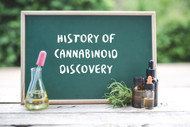A History of Cannabinoid Discovery
Apr 17th 2024
The popularity of hemp-derived cannabinoids only really started gaining momentum in just the past few years, so you may be surprised to learn that most of the "new" cannabinoids we see on the market today - like THC-O, HHC, and Delta 8 - were actually first discovered decades ago!
With how well-known CBD and THC are in terms of cannabinoids, you may assume that these have been around the longest, when in fact, Cannabinol (CBN) was the first phytocannabinoid to be discovered and isolated. This compound was first discovered in a "red oil extract" at the end of the 19th century in 1899.
CBN was originally thought to be the main active component in the plant which gave cannabis its psychoactive properties. The compound's chemical structure was determined in the 1930's by R.S. Cahn, and its first chemical synthesis was achieved in the 1940's by American chemist Roger Adams.
Around the same time in 1940, Adams and his laboratory discover the existence of a second phytocannabinoid, Cannabidiol (CBD), and THC's were discovered shortly after in 1942 by researchers Wollner, Matchett, Levine and Loewe, "most likely as a mixture of Delta 8 and Delta 9 THC." (The chemical structures of these compounds are later isolated and defined by renowned Israeli cannabis researcher, Raphael Mechoulam, in the 1960's.)
In 1941, Adams's team at the University of Illinois published the first known paper announcing the successful synthesis of Delta 8 THC. The team began their first human trials the following year.
Around 1944, Roger Adams becomes the first chemist to synthesize hexahydrocannabinol (HHC) by adding hydrogen molecules to the THC compound.
Between the years 1949 and 1975, it is believed the US Army Chemical Corps at Edgewood Arsenal (a secluded research facility on the shores Maryland’s Chesapeake Bay) first synthesized THC-O or THC acetate. Later in 1978, the DEA conducted a raid on a secret lab in Jacksonville, FL that was attempting to produce THC-O. Another decade later in 1986, "agency chemist Donald A. Cooper noted that the recovered THC-O was in fact an analogue of conventional delta-9 THC. He and other DEA officials dismissed the lab as a one-off experiment and did not see it as a reason for concern."
During the years of 1963 and 1964, Mechoulam's lab first isolated and identified the chemical structures of CBD and THC, respectively.
"It was also in Mechoulam's laboratory, in 1965, that Delta 9 THC and CBD were first synthesized."
Delta 10 THC was first synthesized in the 1980's by Mechoulam's lab during a study that looked at the effects of different THC's on pigeons. The process was reportedly very difficult and dangerous to conduct, so no commercial production began following its discovery.
However, Delta 10 THC was re-discovered in 2020-2021, when cannabis manufacturer, Fusion Farms, accidentally synthesized the compound after their crop was contaminated with a flame retardant. Its popularity began to grow following this "new" discovery.
In 2001, Mechoulam and a team of scientists first patented the process for converting CBD to Delta 8 and Delta 9 THC - a process we now refer to as "isomerization."
From this point up until 2018, hemp-derived cannabinoids were a "negligible part of the marijuana industry," because up until that time, all cannabinoids were just as illegal as Delta 9 THC in the eyes of the federal government.
However, everything changed in December of 2018 when the Agriculture Improvement Act of 2018, better known as the "Farm Bill," was passed into law. This act was the first step into the hemp and CBD boom.
Eventually, "legally-savvy" producers realized that not only did the Farm Bill legalize the sale and manufacture of CBD products made from hemp, it technically made all cannabinoids from hemp with less than 0.3% THC legal. Once this idea spread, so did the demand for more hemp-derived cannabinoids - especially ones that mimic the effects of Delta 9 THC.
Sources:
1. https://www.leafly.com/news/science-tech/who-inven...

